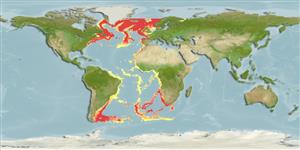Elasmobranchii (tubarões e raias) (sharks and rays) >
Squaliformes (Sleeper and dogfish sharks) >
Etmopteridae (Lantern sharks)
Etymology: Centroscyllium: Greek, kentron = sting + Greek, skylla = a kind of shark (Ref. 45335).
Environment: milieu / climate zone / depth range / distribution range
Ecologia
marinhas batidemersal, usually 180 - 2250 m (Ref. 117245). Deep-water; 1°C - 5°C (Ref. 117245); 68°N - 57°S, 99°W - 120°E (Ref. 55215)
Northwest Atlantic: South Baffin Island and Greenland to Virginia, USA and possibly the Gulf of Mexico. Eastern Atlantic: Iceland along Atlantic slope to Senegal; Guinea to Sierra Leone; Namibia to Quoin Point, South Africa (Ref. 5578). Southwest Atlantic: Uruguay to Argentina (Ref. 58839).
Comprimento de primeira maturação / Tamanho / Peso / Idade
Maturity: Lm 64.0, range 58 - 70 cm
Max length : 107 cm TL macho/indeterminado; (Ref. ); common length : 84.0 cm TL macho/indeterminado; (Ref. 247); common length :70 cm TL (female)
Adults uniformly blackish; fins of juveniles with white margins (Ref. 6577).
Found on the outermost continental shelves and upper slopes, mostly below 275 m (Ref. 247). Epibenthic-pelagic (Ref. 58426). At high latitudes, may move up to the surface especially during the winter (Ref. 247). Bottom water temp. Are from 3.5 to 4.5°C, but sometimes down to 1°C. Segregation by sex and size as well as by movement into shallower water and by increase in school size is sometimes seen. Feeds on crustaceans, cephalopods, jellyfish and small fishes. Ovoviviparous (Ref. 205), with at least 14 pups in a litter (Ref. 247). Has luminescent organs in skin. May reach 107 cm.
Ciclo de vida ou comportamento de acasalamento
Maturities | Reprodução | Spawnings | Egg(s) | Fecundities | Larvas
Distinct pairing with embrace (Ref. 205).
Compagno, L.J.V., 1984. FAO Species Catalogue. Vol. 4. Sharks of the world. An annotated and illustrated catalogue of shark species known to date. Part 1 - Hexanchiformes to Lamniformes. FAO Fish. Synop. 125(4/1):1-249. Rome, FAO. (Ref. 247)
Status na Lista Vermelha da UICN (Ref. 130435)
Ameaça para os humanos
Harmless
Uso pelos humanos
Pescarias: pesca de subsistência
Ferramentas
Relatórios especiais
Baixar XML
Fontes da internet
Estimates based on models
Preferred temperature (Ref.
123201): 1.6 - 9.9, mean 4.2 °C (based on 219 cells).
Índice de diversidade filogenética (Ref.
82804): PD
50 = 0.5078 [Uniqueness, from 0.5 = low to 2.0 = high].
Bayesian length-weight: a=0.00288 (0.00159 - 0.00523), b=3.08 (2.91 - 3.25), in cm total length, based on LWR estimates for this species & (Sub)family-body (Ref.
93245).
Nível Trófico (Ref.
69278): 3.8 ±0.3 se; based on diet studies.
Resiliência (Ref.
120179): Baixo, tempo mínimo de duplicação da população 4,5 - 14 anos (Fec=14).
Fishing Vulnerability (Ref.
59153): High vulnerability (64 of 100).
Climate Vulnerability (Ref.
125649): Moderate vulnerability (38 of 100).
Nutrients (Ref.
124155): Calcium = 6.51 [1.15, 36.11] mg/100g; Iron = 0.304 [0.072, 1.034] mg/100g; Protein = 17.9 [15.9, 20.6] %; Omega3 = 0.262 [0.092, 0.828] g/100g; Selenium = 17.1 [4.9, 53.5] μg/100g; VitaminA = 13.3 [2.5, 68.9] μg/100g; Zinc = 0.352 [0.164, 0.692] mg/100g (wet weight); based on
nutrient studies.
